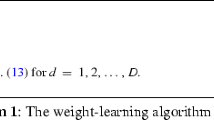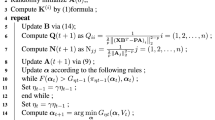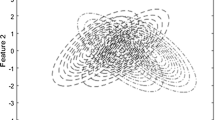Abstract
Kernel density estimation, which is a non-parametric method about estimating probability density distribution of random variables, has been used in feature selection. However, existing feature selection methods based on kernel density estimation seldom consider interval-valued data. Actually, interval-valued data exist widely. In this paper, a feature selection method based on kernel density estimation for interval-valued data is proposed. Firstly, the kernel function in kernel density estimation is defined for interval-valued data. Secondly, the interval-valued kernel density estimation probability structure is constructed by the defined kernel function, including kernel density estimation conditional probability, kernel density estimation joint probability and kernel density estimation posterior probability. Thirdly, kernel density estimation entropies for interval-valued data are proposed by the constructed probability structure, including information entropy, conditional entropy and joint entropy of kernel density estimation. Fourthly, we propose a feature selection approach based on kernel density estimation entropy. Moreover, we improve the proposed feature selection algorithm and propose a fast feature selection algorithm based on kernel density estimation entropy. Finally, comparative experiments are conducted from three perspectives of computing time, intuitive identifiability and classification performance to show the feasibility and the effectiveness of the proposed method.






Similar content being viewed by others
References
Javidi MM, Eskandari S (2018) Streamwise feature selection: a rough set method. Int J Mach Learn Cybernet 9(4):667–676
Li JZ, Yang XB, Song XN, Wang PX, Yu DJ (2019) Neighborhood attribute reduction: a multi-criterion approach. Int J Mach Learn Cybernet 10(4):731–742
Dai JH, Hu QH, Hu H, Huang DB (2018) Neighbor inconsistent pair selection for attribute reduction by rough set approach. IEEE Trans Fuzzy Syst 26(2):937–950
Shang RH, Chang JW, Jiao LC, Xue Y (2019) Unsupervised feature selection based on self-representation sparse regression and local similarity preserving. Int J Mach Learn Cybernet 10(4):757–770
Dai JH, Hu QH, Zhang JH, Hu H, Zheng NG (2017) Attribute selection for partially labeled categorical data by rough set approach. IEEE Trans Cybernet 47(9):2460–2471
Dai JH (2013) Rough set approach to incomplete numerical data. Inf Sci 240:43–57
Wang CZ, Qi YL, Shao MW, Hu QH, Chen DG, Qian YH, Lin YJ (2017) A fitting model for feature selection with fuzzy rough sets. IEEE Trans Fuzzy Syst 25(4):741–753
Dai JH, Hu H, Wu WZ, Qian YH, Huang DB (2018) Maximal-discernibility-pair-based approach to attribute reduction in fuzzy rough sets. IEEE Trans Fuzzy Syst 26(4):2174–2187
Zhang X, Mei CL, Chen DG, Li JH (2016) Feature selection in mixed data: A method using a novel fuzzy rough set-based information entropy. Pattern Recogn 56:1–15
Dai JH, Xu Q (2013) Attribute selection based on information gain ratio in fuzzy rough set theory with application to tumor classification. Appl Soft Comput 13(1):211–221
Dai JH, Han HF, Hu QH, Liu MF (2016) Discrete particle swarm optimization approach for cost sensitive attribute reduction. Knowl-Based Syst 102:116–126
Ashour AS, Guo Y, Kucukkulahli E, Erdogmus P, Polat K (2018) A hybrid dermoscopy images segmentation approach based on neutrosophic clustering and histogram estimation. Appl Soft Comput 69:426–434
Parzen E (1962) On estimation of a probability density function and mode. Ann Math Stat 3(33):1065–1076
Rosenblatt M (1956) Remarks on some nonparametric estimates of a density function. Ann Math Stat, pp 832–837
Banerjee A, Burlina P (2010) Efficient particle filtering via sparse kernel density estimation. IEEE Trans Image Process 19(9):2480–2490
Cai XJ, Wu ZF, Cheng J (2012) Using kernel density estimation to assess the spatial pattern of road density and its impact on landscape fragmentation. Int J Geogr Inf Sci 27:1–9
Qian PJ, Wang ST, Deng ZH (2011) Fast adaptive similarity-based clustering using sparse parzen window density estimation. Acta Autom Sin 37(2):179–187
Rouhani M, Mohammadi M, Kargarian A (2016) Parzen window density estimator-based probabilistic power flow with correlated uncertainties. IEEE Trans Sustain Energy 7(3):1170–1181
Schller H, Hartmann U (1992) Mapping neural network derived from the parzen window estimator. Neural Netw 5(6):903–909
Wang S, Chung F, Xiong F (2008) A novel image thresholding method based on parzen window estimate. Pattern Recogn 41(1):117–129
Wang SC, Gao R, Wang LM (2016) Bayesian network classifiers based on gaussian kernel density. Expert Syst Appl 51:207–217
Yang SS, Zheng F, Luo X, Cai SX, Wu YF, Liu KZ, Wu MH, Chen J, Krishnan S (2014) Effective dysphonia detection using feature dimension reduction and kernel density estimation for patients with parkinsons disease. PLoS ONE 9(2):e88825
Yu WH, Ai TH, Shao SW (2015) The analysis and delimitation of central business district using network kernel density estimation. J Transp Geogr 45:32–47
Kwak N, Choi CH (2002) Input feature selection by mutual information based on parzen window. IEEE Trans Pattern Anal Mach Intell 24(12):1667–1671
Xu SQ, Dai JH, Shi H (2018) Semi-supervised feature selection by mutual information based on kernel density estimation. In: 24th international conference on pattern recognition (ICPR), pp 818–823
Zhang JH (2017) Kernel density estimation entropy for mixed data and fast greedy feature selection algorithms. Master’s thesis, Zhejiang university
Dai JH, Wang WT, Xu Q, Tian HW (2012) Uncertainty measurement for interval-valued decision systems based on extended conditional entropy. Knowl-Based Syst 27:443–450
Dai JH, Wang WT, Mi JS (2013) Uncertainty measurement for interval-valued information systems. Inf Sci 251:63–78
Du WS, Hu BQ (2014) Approximate distribution reducts in inconsistent interval-valued ordered decision tables. Inf Sci 271:93–114
Yang XB, Qi Yong YDJ, Yu HL, Yang JY (2015) \(\alpha\)-Dominance relation and rough sets in interval-valued information systems. Inf Sci 294:334–347
Dai JH, Zheng GJ, Han HF, Hu QH, Zheng NG, Liu J, Zhang QL (2017) Probability approach for interval-valued ordered decision systems in dominance-based fuzzy rough set theory. J Intell Fuzzy Syst 32(1):701–703
Guru DS, Kumar NV, Suhil M (2017) Feature selection of interval valued data through interval K-means clustering. Int J Comput Vis Image Process 7:64–80
Li LF (2017) Multi-level interval-valued fuzzy concept lattices and their attribute reduction. Int J Mach Learn Cybernet 8(1):45–56
Dai JH, Hu H, Zheng GJ, Hu QH, Han HF, Shi H (2016) Attribute reduction in interval-valued information systems based on information entropies. Front Inf Technol Electron Eng 17(9):919–928
Dai JH, Yan YJ, Li ZW, Liao BS (2018) Dominance-based fuzzy rough set approach for incomplete interval-valued data. J Intell Fuzzy Syst 34:423–436
Guru DS, Kumar NV (2020) Interval chi-square score (ICSS): feature selection of interval valued data. Adv Intell Syst Comput 941:686–698
Gatenby RA, Frieden BR (2008) Inf Theory and Entropy. Springer, New York
Wang XZ, Xing HJ, Li Y, Hua Q, Dong CR, Pedrycz W (2015) A study on relationship between generalization abilities and fuzziness of base classifiers in ensemble learning. IEEE Trans Fuzzy Syst 23(5):1638–1654
Wang R, Wang XZ, Kwong S, Xu C (2017) Incorporating diversity and informativeness in multiple-instance active learning. IEEE Trans Fuzzy Syst 25(6):1460–1475
Wang XZ, Wang R, Xu C (2018) Discovering the relationship between generalization and uncertainty by incorporating complexity of classification. IEEE Trans Cybernet 48(2):703–715
Zhang GL, Shen H, Shi F, Huo YQ (2015) Block iterative inversion algorithms for large real symmetric matrix. Wirel Interconnect Technol 6:127–129
Grcar J (2011) Mathematicians of Gaussian elimination. Not Am Math Soc 58(6):782–792
Stanimirović PS, Petković MD (2013) Gauss-Jordan elimination method for computing outer inverses. Appl Math Comput 219(9):4667–4679
Hedjazi L, Aguilar MJ, Lann MVL (2011) Similarity-margin based feature selection for symbolic interval data. Pattern Recogn Lett 32(4):578–585
Quevedo J, Puig V, Cembrano G, Blanch J, Aguilar J, Saporta D, Benito G, Hedo M, Molina A (2010) Validation and reconstruction of flow meter data in the barcelona water distribution network. Control Eng Pract 18(6):640–651
Khan J, Wei JS, Ringnér M, Lao HS, Ladanyi M, Westermann F, Berthold F, Schwab M, Antonescu CR, Peterson C, (2001) Classification and diagnostic prediction of cancers using gene expression profiling and artificial neural networks. Nat Med 7(6):673–679
Li JD, Cheng KW, Wang SH, Morstatter F, Trevino RP, Tang JL, Liu H (2018) Feature selection: a data perspective. ACM Comput Surv 9(4):1–45
Dua D, Graff C (2017) UCI machine learning repository. http://archive.ics.uci.edu/ml
Zhang YY, Li TR, Luo C, Zhang JB, Chen HM (2016) Incremental updating of rough approximations in interval-valued information systems under attribute generalization. Inf Sci 373:461–475
Dai JH, Wei BJ, Zhang XH, Zhang QL (2017) Uncertainty measurement for incomplete interval-valued information systems based on \(\alpha\)-weak similarity. Knowl-Based Syst 136:159–171
He DC, Zhang HJ, Hao WN, Zhang R (2015) A robust parzen window mutual information estimator for feature selection with label noise. Intell Data Anal 19:1199–1212
Acknowledgements
This work was supported by the National Natural Science Foundation of China (No. 61976089, No. 61473259, No. 61070074, No. 60703038), and the Hunan Provincial Science & Technology Project Foundation (2018TP1018, 2018RS3065).
Author information
Authors and Affiliations
Corresponding author
Additional information
Publisher's Note
Springer Nature remains neutral with regard to jurisdictional claims in published maps and institutional affiliations.
Rights and permissions
About this article
Cite this article
Dai, J., Liu, Y., Chen, J. et al. Fast feature selection for interval-valued data through kernel density estimation entropy. Int. J. Mach. Learn. & Cyber. 11, 2607–2624 (2020). https://doi.org/10.1007/s13042-020-01131-5
Received:
Accepted:
Published:
Issue Date:
DOI: https://doi.org/10.1007/s13042-020-01131-5




